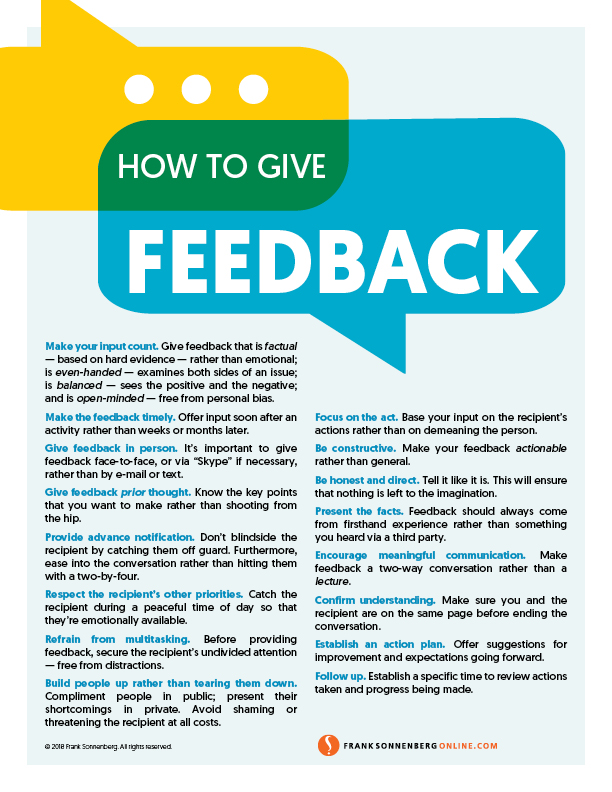
How to Give Feedback
Feedback should be welcomed rather than feared. In fact, we should thank folks who make the effort to nurture us with their valuable input –– even if it hurts at times. Here is how to give feedback:
Make your input count. Give feedback that is factual –– based on hard evidence — rather than emotional; is even-handed –– examines both sides of an issue; is balanced –– sees the positive and the negative; and is open-minded –– free from personal bias.
Make the feedback timely. Offer input soon after an activity rather than weeks or months later. This will ensure that the feedback is relevant and helpful.
Give feedback in person. Input doesn’t have to be formal, but it should be made a priority. For that reason, it’s important to give feedback face-to-face, or via “Skype” if necessary, rather than by e-mail or text. This will enhance communication by providing a more personal and immediate two-way dialog and will enable each party to gauge the other’s body language.
Give feedback prior thought. Know the key points that you want to make rather than shooting from the hip.
Provide advance notification. Don’t blindside the recipient by catching them off guard. Furthermore, ease into the conversation rather than hitting them with a two-by-four.
Respect the recipient’s other priorities. Catch the recipient during a peaceful time of day so that they’re emotionally available. Remember, being present is not the same as being there.
Refrain from multitasking. Before providing feedback, secure the recipient’s undivided attention –– free from distractions.
Build people up rather than tearing them down. Compliment people in public; present their shortcomings in private. Avoid shaming or threatening the recipient at all costs.
Focus on the act. Base your input on the recipient’s actions rather than on demeaning the person.
Be constructive. Make your feedback actionable rather than general.
Be honest and direct. Tell it like it is. This will ensure that nothing is left to the imagination. Furthermore, if your feedback is always glowing, compliments will be less credible.
Present the facts. Feedback should always come from firsthand experience rather than something you heard via a third party.
Encourage meaningful communication. Make feedback a two-way conversation rather than a lecture. Furthermore, the reviewer and recipient must communicate with each other rather than just taking turns talking. And — please give the recipient ample time to respond.
Confirm understanding. Make sure you and the recipient are on the same page before ending the conversation.
Establish an action plan. Offer suggestions for improvement and expectations going forward.
Follow up. Establish a specific time to review actions taken and progress being made.
Do You Know How to Give Feedback?
Please leave a comment and tell us what you think or share it with someone who can benefit from the information.
Additional Reading:
How to Let It Go and Delegate More Effectively
7 Steps to Go from Brutally Blunt to Helpfully Honest
How to Destroy Creativity and Innovation
Do You Promote Excellence?
Are You in Danger of Becoming Complacent?
If you like this article, subscribe to our blog so that you don’t miss a single post. Get future posts by RSS feed, email or Facebook. It’s FREE.





Leave a Comment